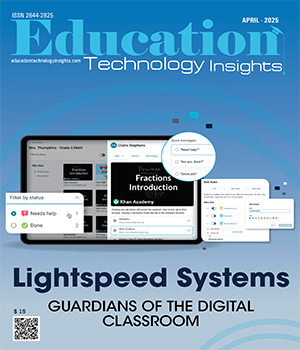THANK YOU FOR SUBSCRIBING
Be first to read the latest tech news, Industry Leader's Insights, and CIO interviews of medium and large enterprises exclusively from Education Technology Insights
Fostering Student Engagement and the Future of Education Technology: A Journey through Queen Mary Academy's Learner Intern Programme of Shared Co-creation and Scholarship
Graeme Hathaway. Interim Head of Innovation and Learning (2022-2023) and current Innovation and Learning Manager. Queen Mary Academy. Queen Mary University of London
 Graeme Hathaway. Interim Head of Innovation and Learning (2022-2023) and current Innovation and Learning Manager. Queen Mary Academy. Queen Mary University of London
Graeme Hathaway. Interim Head of Innovation and Learning (2022-2023) and current Innovation and Learning Manager. Queen Mary Academy. Queen Mary University of London Working within the Queen Mary University of London's central educational development Academy, I have had the privilege of leading a team of bright-thinking individuals known as "innovation and learning" for the past 12 months. During this time, our shared mission has been to create space for educators to explore innovative approaches to teaching and learning, often interlacing technology and pedagogical theory. Our work in this area has included Learner Engagement Analytics (LEA), hybrid teaching models, and immersive learning environments.
In terms of developing, fostering, and cultivating student engagement, one venture clearly stands out in my mind — the Queen Mary Academy (QMA) Learner Intern Programme (LIP). For the past two years, we have been orchestrating the LIP, recruiting current Queen Mary students to collaborate on internal research projects spanning approximately six months. These projects are aligned with strategic themes, endorsed by the educative Senior Executive team, and give students a scholarly voice in shaping their learning experiences. Creation of publishable research reports not only guides the university's future directions but also contributes to broader academic discourse through conferences and journal submissions.
This year, whilst QMA colleagues explored Virtual Reality (VR) hesitancy in medicine and its use in developing communication skills for trainee lawyers, I led a cross-faculty project focused on technologies that can induce a state of "flow" in learning from the student perspective. My research intern and I sought to delve deep into the potential of these tools to transform the learning experience, including those making noise in the sector, e.g., VR, Augmented Reality (AR), and Artificial Intelligence (AI). However, the outcomes were far from what we initially anticipated.
" As I reflect on this journey, I am convinced of the need for harnessing and cultivating the constructive interaction between educators and learners, especially when shaping the future of education technology "
Surprisingly, despite the allure of and publicity around cutting-edge technologies, the familiar PowerPoint retained its grip on students' preferences across disciplines. Many expressed a reluctance to invest time in engaging with VR and AR, despite these technologies being an integral part of their social and gaming experiences. This paradox shed light on the significance (and continued importance) of human connection in education. While VR and AR hold the promise of creating immersive learning experiences, students articulated the need for educators to be clear and convincing as to why and how these technologies were integrated into their learning journeys. A healthy scepticism was apparent, which provides a useful insight.
The students' perspectives highlighted the importance of technology complementing, rather than overshadowing, the learning content if student engagement is to be maximised. They valued PowerPoint for its ability to simplify complex concepts, making learning more approachable. Real-life examples incorporated into slides were praised for bridging the gap between theory and practice, enhancing discussions, and fostering engagement. The significance of technology's accessibility was another powerful revelation. Students with specific learning needs, such as dyslexia, shared how tools such as speech-to-text and AI-powered text generation (e.g. ChatGPT) had transformed their learning experiences.
The insights were not confined to traditional-aged students alone. Our study extended its reach to mature learners (as defined by the UK’s Office for Students) – those who often commute to and from campus and are sometimes underrepresented in such initiatives. The findings revealed both excitement for modern technologies and concerns about usability, support and how they may be expected to perform compared to those more familiar with emerging digital tools.
As I reflect on this journey, I am convinced of the need for harnessing and cultivating the constructive interaction between educators and learners, especially when shaping the future of education technology. For us, the QMA LIP has proven to be a catalyst for improving student engagement, allowing both parties to co-create an educational landscape, thoughtfully and strategically.
Research intern programmes have the potential, as cornerstones of education development, to create the space to not just embrace technological advancements but also foster a transformative learning experience where both educators and learners are active contributors.
Read Also
Goldilocks Regulation
Beyond the Quiz: Redefining Competence in eLearning
Beyond Theory and Into Monday Morning: Enhancing Graduate Programs for Teachers
Safeguarding Students in the Age of Deepfakes: An Educational Imperative
Delivering Excellence in Education through Transformative School Leadership
Curriculum Innovation for Student Success and Institutional Growth

I agree We use cookies on this website to enhance your user experience. By clicking any link on this page you are giving your consent for us to set cookies. More info

























